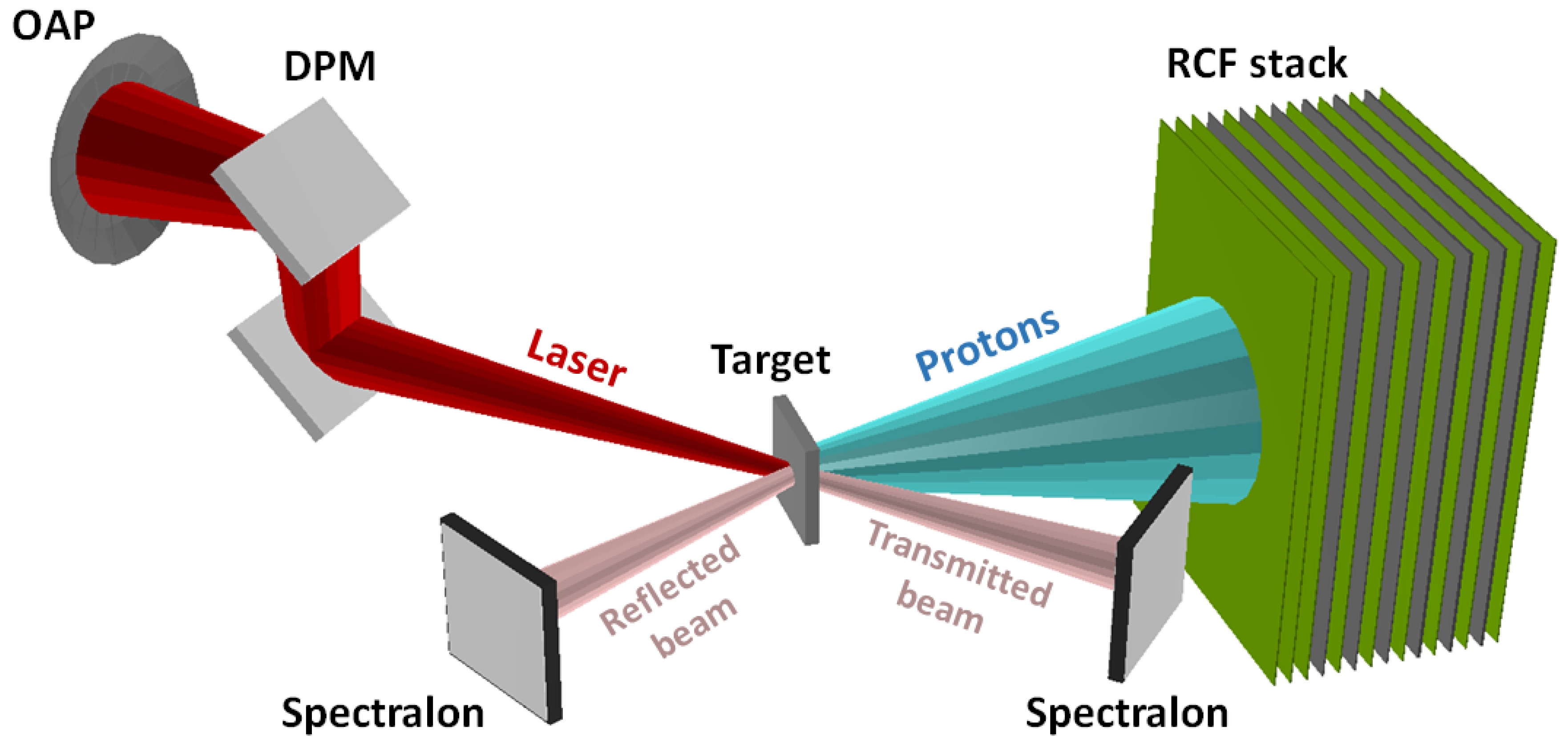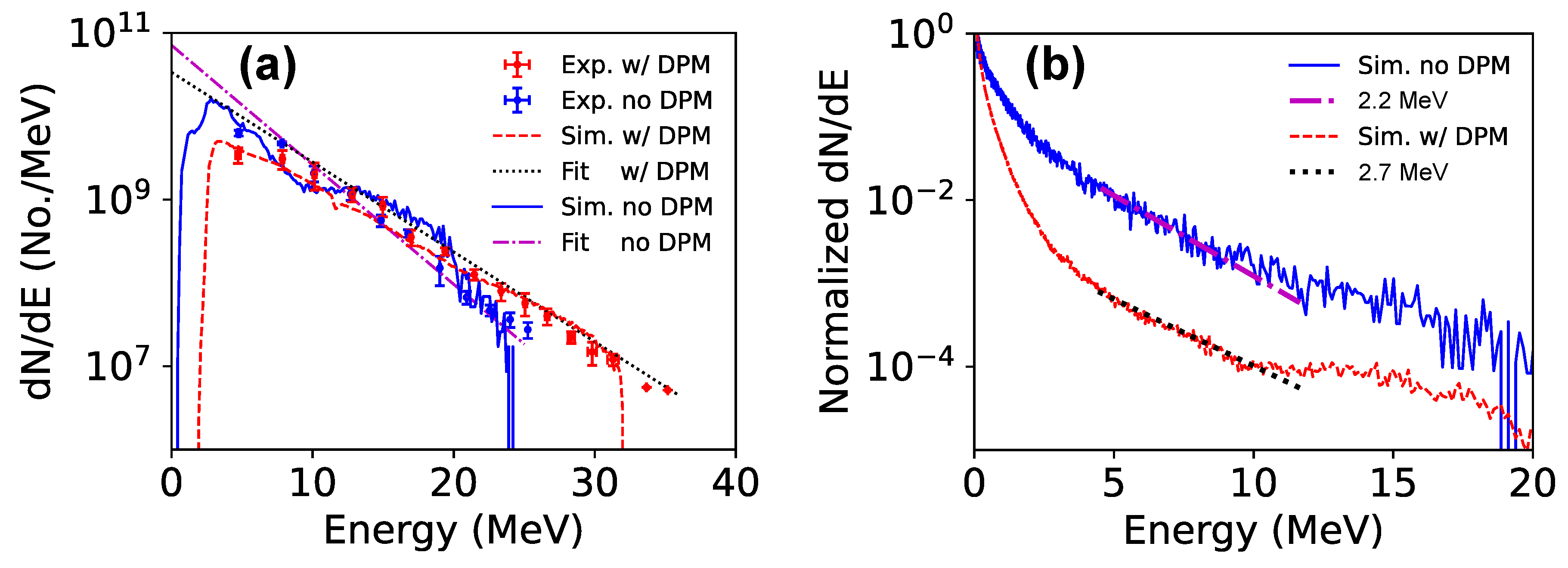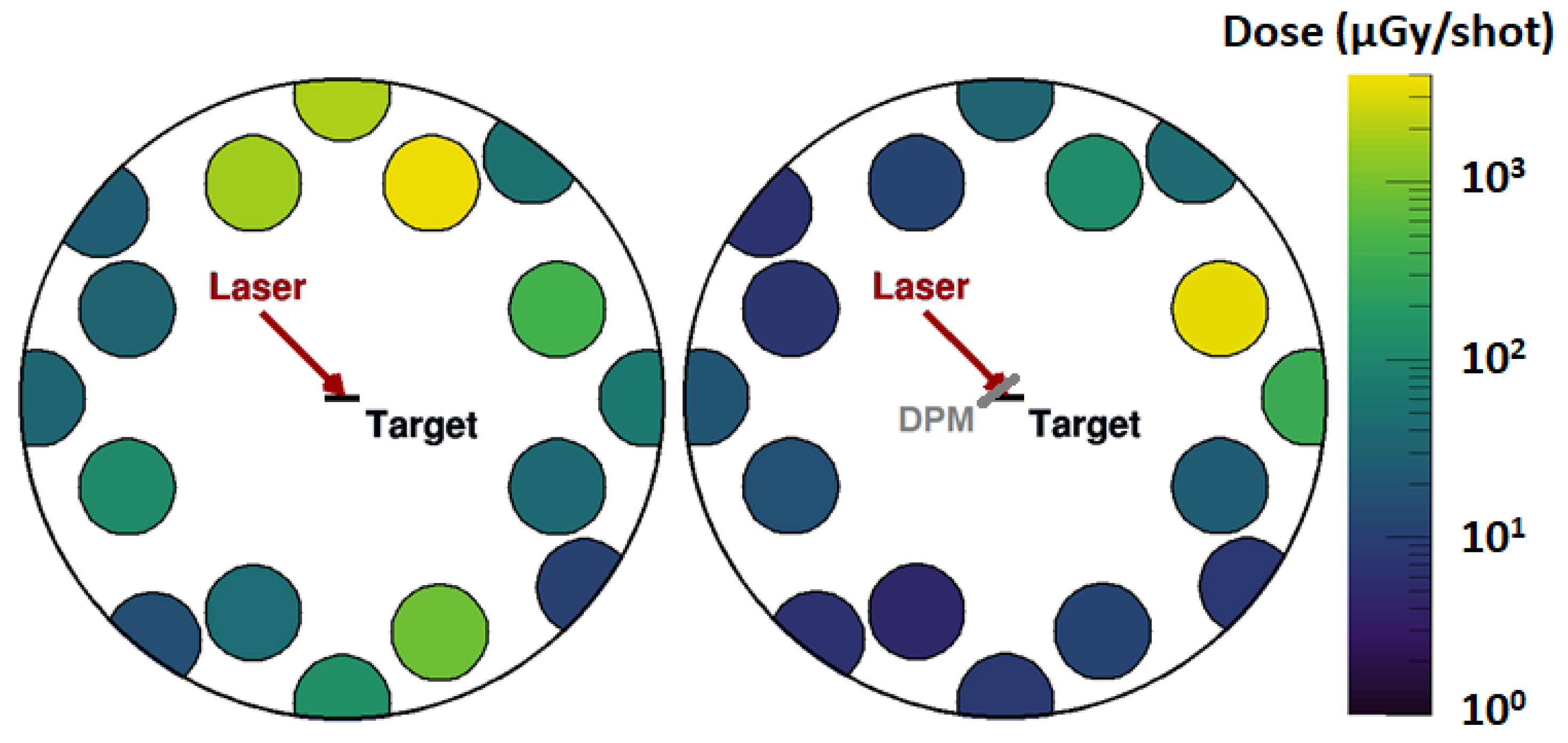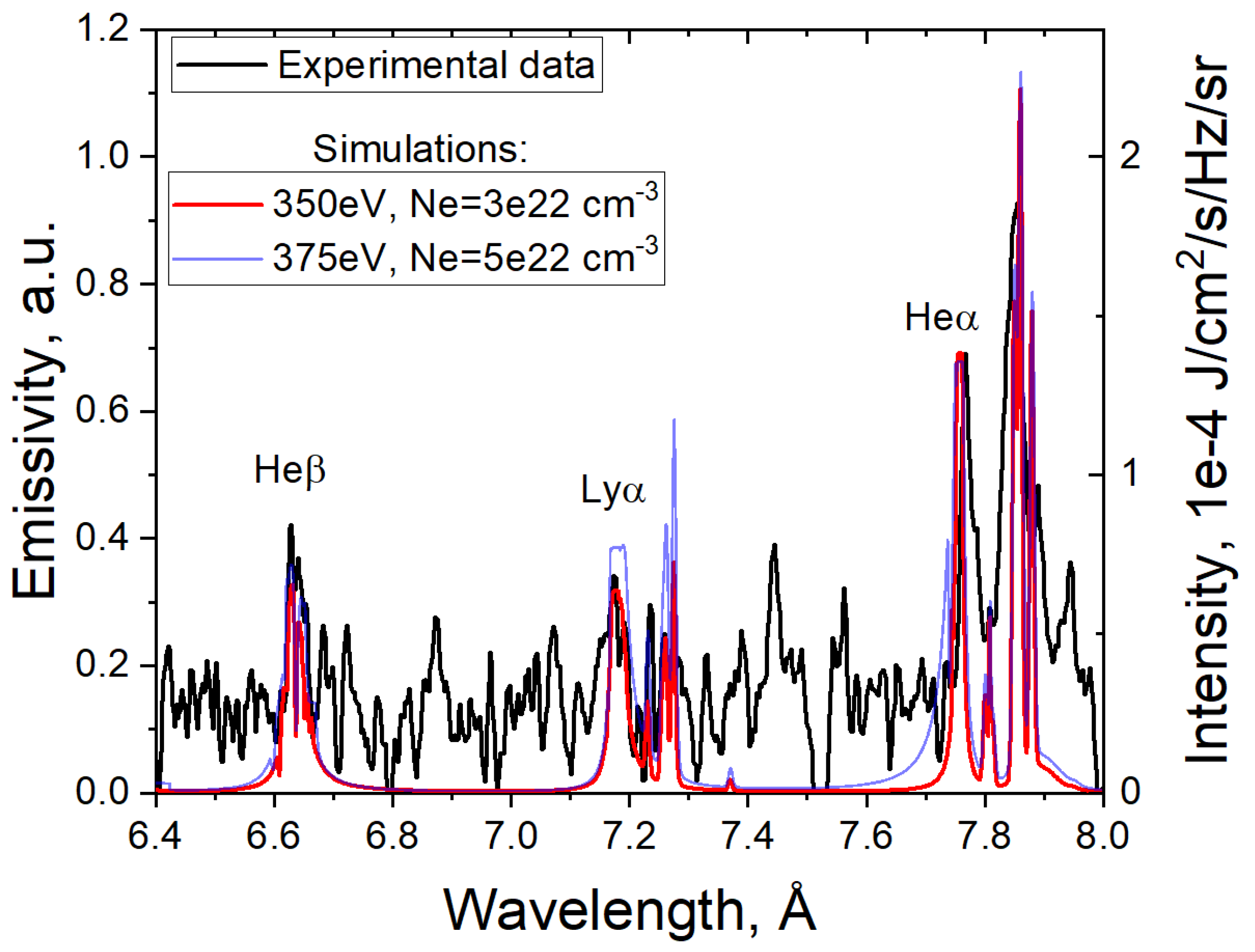Submitted:
27 May 2024
Posted:
27 May 2024
You are already at the latest version
Abstract
Keywords:
1. Introduction
2. Experimental Setup
3. Experimental Results
3.1. Increased Proton Energies
3.2. Improved Proton Beam Profile
3.3. X-ray Emission
4. Numerical PIC Modeling
5. Conclusions
Author Contributions
Funding
Data Availability Statement
Acknowledgments
Conflicts of Interest
References
- Daido, H.; Nishiuchi, M.; Pirozhkov, A.S. Review of laser-driven ion sources and their applications. Reports on progress in physics 2012, 75, 056401. [Google Scholar] [CrossRef] [PubMed]
- Macchi, A.; Borghesi, M.; Passoni, M. Ion acceleration by superintense laser-plasma interaction. Reviews of Modern Physics 2013, 85, 751. [Google Scholar] [CrossRef]
- Zimmer, M.; Scheuren, S.; Ebert, T.; Schaumann, G.; Schmitz, B.; Hornung, J.; Bagnoud, V.; Rödel, C.; Roth, M. Analysis of laser-proton acceleration experiments for development of empirical scaling laws. Physical Review E 2021, 104. [Google Scholar] [CrossRef] [PubMed]
- Schaeffer, D.B.; Bott, A.F.; Borghesi, M.; Flippo, K.A.; Fox, W.; Fuchs, J.; Li, C.; Séguin, F.H.; Park, H.S.; Tzeferacos, P.; et al. Proton imaging of high-energy-density laboratory plasmas. Reviews of Modern Physics 2023, 95. [Google Scholar] [CrossRef]
- Bin, J.; Obst-Huebl, L.; Mao, J.H.; Nakamura, K.; Geulig, L.D.; Chang, H.; Ji, Q.; He, L.; De Chant, J.; Kober, Z. A new platform for ultra-high dose rate radiobiological research using the BELLA PW laser proton beamline. Scientific reports 2022, 12, 1484. [Google Scholar] [CrossRef] [PubMed]
- Lelasseux, V.; Söderström, P.A.; Aogaki, S.; Burdonov, K.; Chen, S.; Cvetinovic, A.; Dechefdebien, E.; Dorard, S.; Fazzini, A.; Gremillet, L. Experimental investigation of the effect of ionization on the 51V (p, n) 51Cr reaction. arXiv 2023, arXiv:2309.16340 2023. [Google Scholar]
- Kroll, F.; Brack, F.E.; Bernert, C.; Bock, S.; Bodenstein, E.; Brüchner, K.; Cowan, T.E.; Gaus, L.; Gebhardt, R.; Helbig, U. Tumour irradiation in mice with a laser-accelerated proton beam. Nature Physics 2022, 18, 316–322. [Google Scholar] [CrossRef]
- Roth, M.; Jung, D.; Falk, K.; Guler, N.; Deppert, O.; Devlin, M.; Favalli, A.; Fernandez, J.; Gautier, D.; Geissel, M. Bright laser-driven neutron source based on the relativistic transparency of solids. Physical review letters 2013, 110, 044802. [Google Scholar] [CrossRef] [PubMed]
- Higginson, D.; Vassura, L.; Gugiu, M.; Antici, P.; Borghesi, M.; Brauckmann, S.; Diouf, C.; Green, A.; Palumbo, L.; Petrascu, H. Temporal narrowing of neutrons produced by high-intensity short-pulse lasers. Physical review letters 2015, 115, 054802. [Google Scholar] [CrossRef] [PubMed]
- Kleinschmidt, A.; Bagnoud, V.; Deppert, O.; Favalli, A.; Frydrych, S.; Hornung, J.; Jahn, D.; Schaumann, G.; Tebartz, A.; Wagner, F.; et al. Intense, directed neutron beams from a laser-driven neutron source at PHELIX. Physics of Plasmas 2018, 25. [Google Scholar] [CrossRef]
- Lelièvre, R.; Yao, W.; Waltenspiel, T.; Cohen, I.; Beck, A.; Cohen, E.; Michaeli, D.; Pomerantz, I.; Gautier, D.C.; Trompier, F. A Comprehensive Characterization of the Neutron Fields Produced by the Apollon Petawatt Laser. arXiv 2023, arXiv:2311.12653 2023. [Google Scholar]
- Martinez, B.; Chen, S.; Bolaños, S.; Blanchot, N.; Boutoux, G.; Cayzac, W.; Courtois, C.; Davoine, X.; Duval, A.; Horny, V. Numerical investigation of spallation neutrons generated from petawatt-scale laser-driven proton beams. Matter and Radiation at Extremes 2022, 7. [Google Scholar] [CrossRef]
- Yogo, A.; Lan, Z.; Arikawa, Y.; Abe, Y.; Mirfayzi, S.; Wei, T.; Mori, T.; Golovin, D.; Hayakawa, T.; Iwata, N. Laser-driven neutron generation realizing single-shot resonance spectroscopy. Physical Review X 2023, 13, 011011. [Google Scholar] [CrossRef]
- Hornỳ, V.; Chen, S.N.; Davoine, X.; Gremillet, L.; Fuchs, J. Quantitative feasibility study of sequential neutron captures using intense lasers. Physical Review C 2024, 109, 025802. [Google Scholar] [CrossRef]
- Ziegler, T.; Göthel, I.; Assenbaum, S.; Bernert, C.; Brack, F.E.; Cowan, T.E.; Dover, N.P.; Gaus, L.; Kluge, T.; Kraft, S.; et al. Laser-driven high-energy proton beams from cascaded acceleration regimes. Nature Physics 2024. [Google Scholar] [CrossRef]
- Wilks, S.; Langdon, A.; Cowan, T.; Roth, M.; Singh, M.; Hatchett, S.; Key, M.; Pennington, D.; MacKinnon, A.; Snavely, R. Energetic proton generation in ultra-intense laser–solid interactions. Physics of plasmas 2001, 8, 542–549. [Google Scholar] [CrossRef]
- Mora, P. Thin-foil expansion into a vacuum. Physical Review E 2005, 72, 056401. [Google Scholar] [CrossRef] [PubMed]
- Mackinnon, A.J.; Borghesi, M.; Hatchett, S.; Key, M.H.; Patel, P.K.; Campbell, H.; Schiavi, A.; Snavely, R.; Wilks, S.C.; Willi, O. Effect of Plasma Scale Length on Multi-MeV Proton Production by Intense Laser Pulses. Physical Review Letters 2001, 86, 1769–1772. [Google Scholar] [CrossRef] [PubMed]
- McKenna, P.; Ledingham, K.W.D.; Yang, J.M.; Robson, L.; McCanny, T.; Shimizu, S.; Clarke, R.J.; Neely, D.; Spohr, K.; Chapman, R.; et al. Characterization of proton and heavier ion acceleration in ultrahigh-intensity laser interactions with heated target foils. Physical Review E 2004, 70. [Google Scholar] [CrossRef] [PubMed]
- Fuchs, J.; Sentoku, Y.; Karsch, S.; Cobble, J.; Audebert, P.; Kemp, A.; Nikroo, A.; Antici, P.; Brambrink, E.; Blazevic, A.; et al. Comparison of Laser Ion Acceleration from the Front and Rear Surfaces of Thin Foils. Physical Review Letters 2005, 94. [Google Scholar] [CrossRef] [PubMed]
- Bolton, P.; Borghesi, M.; Brenner, C.; Carroll, D.; De Martinis, C.; Fiorini, F.; Flacco, A.; Floquet, V.; Fuchs, J.; Gallegos, P. Instrumentation for diagnostics and control of laser-accelerated proton (ion) beams. Physica Medica 2014, 30, 255–270. [Google Scholar] [CrossRef] [PubMed]
- Fuchs, J.; Antici, P.; d’Humières, E.; Lefebvre, E.; Borghesi, M.; Brambrink, E.; Cecchetti, C.; Kaluza, M.; Malka, V.; Manclossi, M. Laser-driven proton scaling laws and new paths towards energy increase. Nature physics 2006, 2, 48–54. [Google Scholar] [CrossRef]
- Dromey, B.; Coughlan, M.; Senje, L.; Taylor, M.; Kuschel, S.; Villagomez-Bernabe, B.; Stefanuik, R.; Nersisyan, G.; Stella, L.; Kohanoff, J.; et al. Picosecond metrology of laser-driven proton bursts. Nature Communications 2016, 7. [Google Scholar] [CrossRef] [PubMed]
- Ma, W.; Kim, I.J.; Yu, J.; Choi, I.W.; Singh, P.; Lee, H.W.; Sung, J.H.; Lee, S.K.; Lin, C.; Liao, Q. Laser acceleration of highly energetic carbon ions using a double-layer target composed of slightly underdense plasma and ultrathin foil. Physical Review Letters 2019, 122, 014803. [Google Scholar] [CrossRef] [PubMed]
- Danson, C.N.; Haefner, C.; Bromage, J.; Butcher, T.; Chanteloup, J.C.F.; Chowdhury, E.A.; Galvanauskas, A.; Gizzi, L.A.; Hein, J.; Hillier, D.I. Petawatt and exawatt class lasers worldwide. High Power Laser Science and Engineering 2019, 7, e54. [Google Scholar] [CrossRef]
- Stockem Novo, A.; Kaluza, M.; Fonseca, R.; Silva, L. Optimizing laser-driven proton acceleration from overdense targets. Scientific reports 2016, 6, 29402. [Google Scholar] [CrossRef] [PubMed]
- Yan, X.; Lin, C.; Sheng, Z.M.; Guo, Z.; Liu, B.; Lu, Y.; Fang, J.; Chen, J. Generating high-current monoenergetic proton beams by a circularlypolarized laser pulse in the phase-stableacceleration regime. Physical Review Letters 2008, 100, 135003. [Google Scholar] [CrossRef] [PubMed]
- Qiao, B.; Zepf, M.; Borghesi, M.; Dromey, B.; Geissler, M.; Karmakar, A.; Gibbon, P. Radiation-pressure acceleration of ion beams from nanofoil targets: The leaky light-sail regime. Physical review letters 2010, 105, 155002. [Google Scholar] [CrossRef] [PubMed]
- Martin, P.; Ahmed, H.; Doria, D.; Cerchez, M.; Hanton, F.; Gwynne, D.; Alejo, A.; Fernández-Tobías, J.; Green, J.; Macchi, A. Narrow-band acceleration of gold ions to GeV energies from ultra-thin foils. Communications Physics 2024, 7, 3. [Google Scholar] [CrossRef]
- Yin, L.; Albright, B.; Hegelich, B.; Bowers, K.J.; Flippo, K.; Kwan, T.; Fernández, J. Monoenergetic and GeV ion acceleration from the laser breakout afterburner using ultrathin targets. Physics of plasmas 2007, 14. [Google Scholar] [CrossRef]
- Palaniyappan, S.; Hegelich, B.M.; Wu, H.C.; Jung, D.; Gautier, D.C.; Yin, L.; Albright, B.J.; Johnson, R.P.; Shimada, T.; Letzring, S. Dynamics of relativistic transparency and optical shuttering in expanding overdense plasmas. Nature Physics 2012, 8, 763–769. [Google Scholar] [CrossRef]
- Chou, H.G.J.; Grassi, A.; Glenzer, S.H.; Fiuza, F. Radiation pressure acceleration of high-quality ion beams using ultrashort laser pulses. Physical Review Research 2022, 4, L022056. [Google Scholar] [CrossRef]
- Rehwald, M.; Assenbaum, S.; Bernert, C.; Brack, F.E.; Bussmann, M.; Cowan, T.E.; Curry, C.B.; Fiuza, F.; Garten, M.; Gaus, L. Ultra-short pulse laser acceleration of protons to 80 MeV from cryogenic hydrogen jets tailored to near-critical density. Nature communications 2023, 14, 4009. [Google Scholar] [CrossRef] [PubMed]
- Antici, P.; Fuchs, J.; d’Humières, E.; Lefebvre, E.; Borghesi, M.; Brambrink, E.; Cecchetti, C.; Gaillard, S.; Romagnani, L.; Sentoku, Y. Energetic protons generated by ultrahigh contrast laser pulses interacting with ultrathin targets. Physics of Plasmas 2007, 14. [Google Scholar] [CrossRef]
- Lévy, A.; Ceccotti, T.; D’Oliveira, P.; Réau, F.; Perdrix, M.; Quéré, F.; Monot, P.; Bougeard, M.; Lagadec, H.; Martin, P. Double plasma mirror for ultrahigh temporal contrast ultraintense laser pulses. Optics letters 2007, 32, 310–312. [Google Scholar] [CrossRef]
- Schumacher, D.W.; Zingale, A.; Czapla, N.; Nasir, D.; Cochran, G.E.; Poole, P.L. Liquid Crystal Targets And Plasma Mirrors For PW-Class Laser Experiments. OSA High-brightness Sources and Light-driven Interactions Congress 2020 (EUVXRAY, HILAS, MICS). Optica Publishing Group, 2020, HILAS. [CrossRef]
- Dollar, F.; Zulick, C.; Matsuoka, T.; McGuffey, C.; Bulanov, S.; Chvykov, V.; Davis, J.; Kalinchenko, G.; Petrov, G.; Willingale, L. High contrast ion acceleration at intensities exceeding 1021 Wcm-2. Physics of Plasmas 2013, 20. [Google Scholar] [CrossRef]
- Speicher, M.; Haffa, D.; Haug, M.A.; Bin, J.; Gao, Y.; Hartmann, J.; Hilz, P.; Kreuzer, C.; Lindner, F.H.; Ostermayr, T.M.; others. Integrated double-plasma-mirror targets for contrast enhancement in laser ion acceleration. Journal of Physics: Conference Series. IOP Publishing, 2018, Vol. 1079, p. 012002.
- Neely, D.; Foster, P.; Robinson, A.; Lindau, F.; Lundh, O.; Persson, A.; Wahlström, C.G.; McKenna, P. Enhanced proton beams from ultrathin targets driven by high contrast laser pulses. Applied Physics Letters 2006, 89. [Google Scholar] [CrossRef]
- Antici, P.; Fuchs, J.; d’Humières, E.; Robiche, J.; Brambrink, E.; Atzeni, S.; Schiavi, A.; Sentoku, Y.; Audebert, P.; Pépin, H. Laser acceleration of high-energy protons in variable density plasmas. New Journal of Physics 2009, 11, 023038. [Google Scholar] [CrossRef]
- Higginson, A.; Gray, R.; King, M.; Dance, R.; Williamson, S.; Butler, N.; Wilson, R.; Capdessus, R.; Armstrong, C.; Green, J. Near-100 MeV protons via a laser-driven transparency-enhanced hybrid acceleration scheme. Nature communications 2018, 9, 724. [Google Scholar] [CrossRef]
- Poole, P.L.; Obst, L.; Cochran, G.E.; Metzkes, J.; Schlenvoigt, H.P.; Prencipe, I.; Kluge, T.; Cowan, T.; Schramm, U.; Schumacher, D.W. Laser-driven ion acceleration via target normal sheath acceleration in the relativistic transparency regime. New Journal of Physics 2018, 20, 013019. [Google Scholar] [CrossRef]
- Burdonov, K.; Fazzini, A.; Lelasseux, V.; Albrecht, J.; Antici, P.; Ayoul, Y.; Beluze, A.; Cavanna, D.; Ceccotti, T.; Chabanis, M. Characterization and performance of the Apollon short-focal-area facility following its commissioning at 1 PW level. Matter and Radiation at Extremes 2021, 6. [Google Scholar] [CrossRef]
- Badziak, J.; Antici, P.; Fuchs, J.; Jabłoński, S.; Mancic, A.; Parys, P.; Rosiński, M.; Suchańska, R.; Szydłowski, A.; Wołowski, J. Laser-induced generation of ultraintense proton beams for high energy-density science. AIP Conference Proceedings. American Institute of Physics, 2008, Vol. 1024, pp. 63–77.
- Mirza, I.; Bulgakova, N.M.; Tomáštík, J.; Michálek, V.; Haderka, O.; Fekete, L.; Mocek, T. Ultrashort pulse laser ablation of dielectrics: Thresholds, mechanisms, role of breakdown. Scientific Reports 2016, 6. [Google Scholar] [CrossRef] [PubMed]
- Burdonov, K.; Lelièvre, R.; Forestier-Colleoni, P.; Ceccotti, T.; Cuciuc, M.; Lancia, L.; Yao, W.; Fuchs, J. Absolute calibration up to 20 MeV of an online readout CMOS system suitable to detect high-power lasers accelerated protons. Review of Scientific Instruments 2023, 94. [Google Scholar] [CrossRef] [PubMed]
- Brenner, C.M.; Robinson, A.P.L.; Markey, K.; Scott, R.H.H.; Gray, R.J.; Rosinski, M.; Deppert, O.; Badziak, J.; Batani, D.; Davies, J.R.; et al. High energy conversion efficiency in laser-proton acceleration by controlling laser-energy deposition onto thin foil targets. Applied Physics Letters 2014, 104. [Google Scholar] [CrossRef]
- Wagner, F.; Bedacht, S.; Bagnoud, V.; Deppert, O.; Geschwind, S.; Jaeger, R.; Ortner, A.; Tebartz, A.; Zielbauer, B.; Hoffmann, D.H.H.; et al. Simultaneous observation of angularly separated laser-driven proton beams accelerated via two different mechanisms. Physics of Plasmas 2015, 22. [Google Scholar] [CrossRef]
- Zhuo, W.; Liu, W.; Huang, G.; Zhu, G.; Ma, G. Comparisons of dosimetric properties between GD-300 series of radiophotoluminescent glass detectors and GR-200 series of thermoluminescent detectors. Nuclear Science and Techniques 2007, 18, 362–365. [Google Scholar]
- Faenov, A.Y.; Pikuz, S.A.; Erko, A.I.; Bryunetkin, B.A.; Dyakin, V.M.; Ivanenkov, G.V.; Mingaleev, A.R.; Pikuz, T.A.; Romanova, V.M.; Shelkovenko, T.A. High-performance x-ray spectroscopic devices for plasma microsources investigations. Physica Scripta 1994, 50, 333–338. [Google Scholar] [CrossRef]
- Vyskočil, J.; Klimo, O.; Weber, S. Simulations of bremsstrahlung emission in ultra-intense laser interactions with foil targets. Plasma Physics and Controlled Fusion 2018, 60, 054013. [Google Scholar] [CrossRef]
- Ryazantsev, S.N.; Martynenko, A.S.; Sedov, M.V.; Skobelev, I.Y.; Mishchenko, M.D.; Lavrinenko, Y.S.; Baird, C.D.; Booth, N.; Durey, P.; Döhl, L.N.K.; et al. Absolute keV x-ray yield and conversion efficiency in over dense Si sub-petawatt laser plasma. Plasma Physics and Controlled Fusion 2022, 64, 105016. [Google Scholar] [CrossRef]
- Chen, M.; Sheng, Z.M.; Zheng, J.; Ma, Y.Y.; Bari, M.; Li, Y.T.; Zhang, J. Surface electron acceleration in relativistic laser-solid interactions. Optics Express 2006, 14, 3093. [Google Scholar] [CrossRef] [PubMed]
- Serebryakov, D.A.; Nerush, E.N.; Kostyukov, I.Y. Near-surface electron acceleration during intense laser–solid interaction in the grazing incidence regime. Physics of Plasmas 2017, 24. [Google Scholar] [CrossRef]
- Thévenet, M.; Leblanc, A.; Kahaly, S.; Vincenti, H.; Vernier, A.; Quéré, F.; Faure, J. Vacuum laser acceleration of relativistic electrons using plasma mirror injectors. Nature Physics 2015, 12, 355–360. [Google Scholar] [CrossRef]
- Chung, H.K.; Chen, M.H.; Morgan, W.L.; Ralchenko, Y.; Lee, R.W. FLYCHK: Generalized population kinetics and spectral model for rapid spectroscopic analysis for all elements. High Energy Density Physics 2005, 1, 3–12. [Google Scholar] [CrossRef]
- Derouillat, J.; Beck, A.; Pérez, F.; Vinci, T.; Chiaramello, M.; Grassi, A.; Flé, M.; Bouchard, G.; Plotnikov, I.; Aunai, N. Smilei: A collaborative, open-source, multi-purpose particle-in-cell code for plasma simulation. Computer Physics Communications 2018, 222, 351–373. [Google Scholar] [CrossRef]
- Grismayer, T.; Mora, P. Influence of a finite initial ion density gradient on plasma expansion into a vacuum. Phys. Plasmas 2006, 13, 032103. [Google Scholar] [CrossRef]
- Hornỳ, V.; Burdonov, K.; Fazzini, A.; Lelasseux, V.; Antici, P.; Chen, S.N.; Ciardi, A.; Davoine, X.; d’Humières, E.; Gremillet, L. A" lighthouse" laser-driven staged proton accelerator allowing for ultrafast angular and spectral control. arXiv 2024, arXiv:2404.11321 2024. [Google Scholar]
- Favalli, A.; Aymond, F.; Bridgewater, J.S.; Croft, S.; Deppert, O.; Devlin, M.J.; Falk, K.; Fernandez, J.C.; Gautier, D.C.; Gonzales, M.A.; others. Nuclear material detection by one-short-pulse-laser-driven neutron source. Technical report, Los Alamos National Lab.(LANL), Los Alamos, NM (United States), 2015.
- Favalli, A.; Guler, N.; Henzlova, D.; Croft, S.; Falk, K.; Gautier, D.C.; Ianakiev, K.D.; Iliev, M.; Palaniyappan, S.; Roth, M. Characterizing laser-plasma ion accelerators driving an intense neutron beam via nuclear signatures. Scientific Reports 2019, 9, 2004. [Google Scholar] [CrossRef] [PubMed]
- Yogo, A.; Mirfayzi, S.R.; Arikawa, Y.; Abe, Y.; Wei, T.; Mori, T.; Lan, Z.; Hoonoki, Y.; Golovin, D.O.; Koga, K.; et al. Single shot radiography by a bright source of laser-driven thermal neutrons and x-rays. Applied Physics Express 2021, 14, 106001. [Google Scholar] [CrossRef]
- Yogo, A.; Lan, Z.; Arikawa, Y.; Abe, Y.; Mirfayzi, S.; Wei, T.; Mori, T.; Golovin, D.; Hayakawa, T.; Iwata, N.; et al. Laser-Driven Neutron Generation Realizing Single-Shot Resonance Spectroscopy. Physical Review X 2023, 13. [Google Scholar] [CrossRef]












Disclaimer/Publisher’s Note: The statements, opinions and data contained in all publications are solely those of the individual author(s) and contributor(s) and not of MDPI and/or the editor(s). MDPI and/or the editor(s) disclaim responsibility for any injury to people or property resulting from any ideas, methods, instructions or products referred to in the content. |
© 2024 by the authors. Licensee MDPI, Basel, Switzerland. This article is an open access article distributed under the terms and conditions of the Creative Commons Attribution (CC BY) license (http://creativecommons.org/licenses/by/4.0/).




